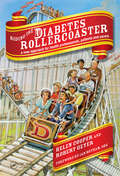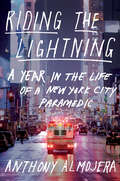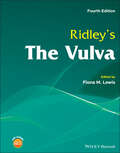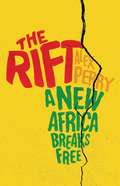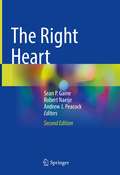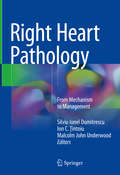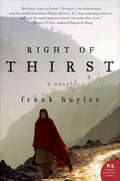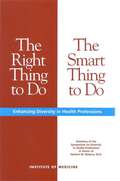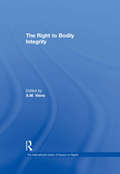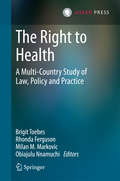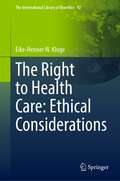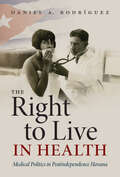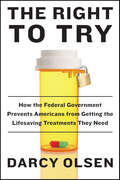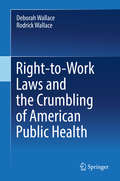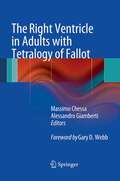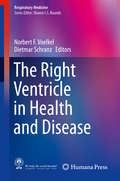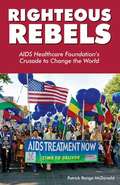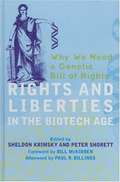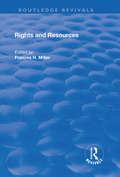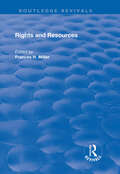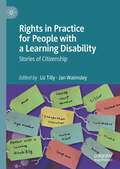- Table View
- List View
Riding the Diabetes Rollercoaster: A Complete Resource for EMQs, v. 2
by Helen Cooper Robert GeyerThis work includes foreword by Ian Botham, OBE, former England Cricket Captain and father of a daughter with Type 1 Diabetes. This groundbreaking book reveals how science and medicine have traditionally tried to make diabetes simple and orderly, despite its obvious messiness and complexity. The result has left patients, carers and health professionals confused and frustrated. Using complexity science, "Riding the Diabetes Rollercoaster" provides a radical new approach to understanding and managing diabetes that embraces its uncertainties and challenges. From a complexity perspective, the diabetes rollercoaster is normal and is a mirror of life itself. Learning to embrace and use the tools of complexity can completely alter your approach to diabetes. "Despite huge amounts of research, funding and effort, diabetes - like many other chronic illnesses - refuses to go away or even to get any easier to deal with. Health professionals have grown increasingly frustrated with their inability to develop radical improvements; patients and carers struggle to comply with complicated self management regimes. We believe that Complexity offers a way forward. Learning to balance rather than control diabetes is the ultimate goal of diabetes management." - Helen Cooper and Robert Geyer, in the Preface.
Riding the Lightning: A Year in the Life of a New York City Paramedic
by Anthony Almojera“An intense look at the high-stakes world of a NYC paramedic in the months before and after COVID-19 altered our landscape.”—Damon Tweedy, MD, author of Black Man in a White Coat: A Doctor's Reflections on Race and MedicineThe education of a New York City paramedic, whose tales of tragedy and transcendence over a single year culminate in the greatest challenge the city’s emergency medical system has ever faced: COVID-19.As a seasoned paramedic and union leader, Anthony Almojera thought he could handle anything his job threw at him. Like many medical first responders, he came from a troubled background and carried the traumas of the city as well as its triumphs. He had grown up in the rough-and-tumble Park Slope of the 1980s, been homeless for a time, and had watched murder, addiction, and hopelessness consume those closest to him. But he had dedicated his life to helping people in need, and while every day was filled with tragedy—stabbings, shootings, accidents, suicides—it also brought moments of uplift: births, resuscitations, and rescues that reminded Anthony and his coworkers why EMS was the most thrilling job on earth, even if the pay was lousy and the hours were long. So when a strange new virus began spreading in New York, Anthony and his fellow medics were ready. They had done the biohazard drills; they knew the procedures, and how to handle the sick and the bereaved. They believed that their lives and training had prepared them for this new challenge. But the months ahead would prove them wrong, and would push New York’s EMS workers, and Anthony himself, to the breaking point—and beyond.Following one paramedic into hell and back, Riding the Lightning tells the story of New York City’s darkest days through the eyes of its frontline medical workers and the community they serve: ordinary people who will continue to make New York an extraordinary place long after it has been reborn from the ashes of the COVID-19 pandemic.
Ridley's The Vulva
by Fiona M. LewisThe leading guide to vulval diseases The newly updated Fourth Edition of Ridley’s The Vulva delivers a practical guide to diagnosing and treating common and uncommon conditions affecting the vulva. The book bridges across the different specialties involved in the study of vulval diseases, offering full colour pictures, a companion website, and a digital companion text. This newest edition provides the most up-to-date guidance on the diagnosis and management of vulval diseases, with extensively revised chapters and brand-new material on paediatric vulval disease, female genital mutilation, and psychological interventions. Finally, a variety of new clinical and histological images are included. The book also provides: A thorough introduction to the basics of vulval disease, including vulval embryology and anatomy, normal vulval microbiology and physiology, and the principles of medical treatment Comprehensive summaries of vulval infections, including herpes simplex, HPV, candidiasis, and ectoparasite infections Practical discussions of all vulval dermatoses, including genetic conditions, and signs of associated systemic disease In-depth information on vulvodynia Discussion of benign, pre-malignant and malignant lesionsPerfect for dermatology, gynecology, pathology, paediatrics, genito-urinary and urology consultants and trainees, Ridley’s The Vulva will also earn a place in the libraries of general practitioners and specialist nurses.
The Rift: A New Africa Breaks Free
by Alex PerryA vivid, powerful and controversial look at how the world gets Africa wrong, and how a resurgent Africa is forcing it to think again.Africa has long been misunderstood--and abused--by outsiders. Correspondent Alex Perry traveled the continent for most of a decade, meeting with entrepreneurs and warlords, professors and cocaine smugglers, presidents and jihadis. Beginning with a devastating investigation into a largely unreported war crime-in 2011, when the US and the major aid agencies helped cause a famine in which 250,000 Somalis died-he finds Africa at a moment of furious self-assertion. To finally win their freedom, Africans must confront three last false prophets-Islamists, dictators and aid workers-who would keep them in their bonds. Beautifully written, intimately reported, and sure to spark debate, THE RIFT passionately argues that a changing Africa revolutionizes our ideas of it, and of ourselves.
The Right Heart
by Sean P. Gaine Robert Naeije Andrew J. PeacockThis heavily revised second edition of this critical book details the structure, function and imaging of the normal right heart both at rest and under the stresses of high altitude and exercise. Extensively revised chapters cover the pathophysiology and pathobiology of right heart dysfunction, both in experimental models and human disease, including congenital heart disease and pulmonary hypertension.The Right Heart provides a concise up-to-date guide on the latest advances in our understanding of role of the right heart in the cardiopulmonary circuit and is an indispensable up-to-date resource for clinicians interested in this topic.
The Right Heart
by Sean P. Gaine Robert Naeije Andrew John PeacockThe heart and lung are intricately linked. When the heart is affected by disease, the lungs will often show some related pathological or clinical conditions and vice versa. Pulmonary heart disease is by definition a condition when the lungs cause the heart to fail. The left ventricle in combination with the other structures in the "left heart" pumps blood throughout the body. The right ventricle (and structures of the "right heart") pumps blood to the lungs where it is oxygenated and returned to the left heart for distribution. In normal circumstances, the right heart pumps blood into the lungs without any resistance. The lungs usually have minimal pressure and the right heart easily pumps blood through. However when there is lung disease present, like emphysema, chronic obstructive lung disease (COPD) or pulmonary hypertension- the small blood vessels become very stiff and rigid. The right ventricle is no longer able to push blood into the lungs and eventually fails. This is known as pulmonary heart disease. Pulmonary heart disease is also known as right heart failure or cor pulmonale. The chief cause of right heart failure is the increase in blood pressure in the lungs (pulmonary artery).
Right Heart Pathology: From Mechanism To Management
by Malcolm John Underwood Ion C. Ţintoiu Silviu Ionel DumitrescuThis book reviews the management of right heart diseases, incorporating etiology, physiopathology, prevention, diagnosis and treatment. The frequency of this pathology has increased in recent years, while techniques for its treatment have evolved. This book therefore represents a complete, detailed and updated presentation of this pathology, reviewing the expanded treatment options while considering the management of patients in detail.Right Heart Pathology: From Mechanism to Management provides a comprehensive insight into right heart pathology, current diagnostic methods, treatments and postsurgical management. Written by experienced cardiologists and cardiovascular surgeons who have addressed significant issues in this topic area, it represents the essential reference in this specialty.
Right of Thirst: A Novel (P. S. Ser.)
by Frank HuylerA grieving doctor seeks redemption as a foreign relief worker—only to be caught in the fog of war—in this “vivid and compassionate” novel (Kirkus).Shattered by his wife’s death, and by his own role in it, successful cardiologist Charles Anderson volunteers to assist with earthquake relief in an impoverished Islamic country in a constant state of conflict with its neighbor. But when the refugees he’s come to help do not appear and artillery begins to fall in the distance along the border, the story takes an unexpected turn.This haunting, resonant tour de force about one man’s desire to live a moral life offers a moving exploration of the tensions between poverty and wealth, the ethics of intervention, the deep cultural differences that divide the world, and the essential human similarities that unite it.
The Right Thing to Do, The Smart Thing to Do Enhancing Diversity in the Health Professions: Summary of the Symposium on Diversity in Health Professions in Honor of Herbert W.Nickens, M.D.
by Brian D. SmedleyThe Symposium on Diversity in the Health Professions in Honor of Herbert W. Nickens, M.D., was convened in March 2001 to provide a forum for health policymakers, health professions educators, education policymakers, researchers, and others to address three significant and contradictory challenges: the continued under-representation of African Americans, Hispanics, and Native Americans in health professions; the growth of these populations in the United States and subsequent pressure to address their health care needs; and the recent policy, legislative, and legal challenges to affirmative action that may limit access for underrepresented minority students to health professions training. The symposium summary along with a collection of papers presented are to help stimulate further discussion and action toward addressing these challenges. The Right Thing to Do, The Smart Thing to Do: Enhancing Diversity in Health Professions illustrates how the health care industry and health care professions are fighting to retain the public’s confidence so that the U.S. health care system can continue to be the world’s best.
The Right to Bodily Integrity (The International Library of Essays on Rights)
by A.M. ViensThe right to bodily integrity has become a notable controversial issue within moral, political and legal discourse and this right is regarded as one of the most precious rights that persons have, alongside the right to life. Recent scholarly debate has focused attention on the content, scope and force of this right and has lead to the recognition that a better understanding of the nature of this right will contribute to determining whether and why a multitude of clinical and research activities in medical practice should be seen as permissible or impermissible. The essays selected for this volume examine topics such as pregnancy and reproduction, altering children’s bodies, transplantation, controversial modifications and surgeries, and experimentation and dead bodies. This is the first collection of scholarly research articles to provide a comprehensive overview of the ethical and legal aspects of the right to bodily integrity and its implications in theory and practice.
The Right to Health
by Brigit Toebes Rhonda Ferguson Milan M. Markovic Obiajulu NnamuchiThis interdisciplinary study engages with the fields of human rights law, health law, and public health. It analyses how the internationally guaranteed human 'right to health' is realized by States at a national level. It brings together scholars from more than ten different countries, with each of them analyzing the right to health in their country or region. They all focus on a particular theme that is important in their country, such as health inequalities, the Millennium Development Goals, or the privatization of healthcare. This book is relevant for scholars, practitioners and policy makers in the field of human rights law, health law, public health and the intersection between these three fields.
The Right to Health at the Public/Private Divide
by Colleen M. Flood Aeyal GrossThrough a comparative global study of countries from all continents representing a diversity of health, legal, political, and economic systems, this book explores the role of health rights to advance greater equality through access to health care. Does health care promote equality, or does it in fact advance the opposite result? Does inserting the idea of "the right to health" into health systems allow the reinsertion of public values into systems that are undergoing privatization? Or does it allow for private claims to be rearticulated as "rights," in a way that actually reinforces inequality? This volume includes studies from countries such as the United States, the United Kingdom, Brazil, Canada, The Netherlands, China, and Nigeria, among many others, as well as authors with expertise regarding both the legal and health systems of their countries, making this a seminal study that allows readers to see the differing role of rights in various health systems.
The Right to Health Care: Ethical Considerations (The International Library of Bioethics #92)
by Eike-Henner W. KlugeThis book provides an in-depth ethical analysis of the right to health care by contrasting privatized with socialized approaches. It pays special attention to how a socialized approach can be implemented in the context of limited resources and offers a way of integrating allocation decisions at the policy level with institutional and hands-on decision-making. It also discusses how the right to health care translates into duties on part of the members of society. In an Appendix, it suggests how, in time of need, the TRIPS Agreement allows countries to side-step patent regulations that would otherwise raise the cost of patented healthcare products beyond what a particular society is able to afford. The book is of interest not only to scholars but also to healthcare policy makers, administrators and healthcare professionals, as well as to patients themselves.
The Right to Know and the Right Not to Know
by Ruth Chadwick Mairi Levitt Darren Shickle Ruth Chadwick Mairi LevittThis volume contains essays which cover a range of aspects in the debate over genetic testing. It looks at both the advantages and disadvantages involved in knowing or not knowing whether one is a carrier of certain genetic traits.
The Right to Live in Health: Medical Politics in Postindependence Havana (Envisioning Cuba)
by Daniel A. RodríguezDaniel A. Rodriguez's history of a newly independent Cuba shaking off the U.S. occupation focuses on the intersection of public health and politics in Havana. While medical policies were often used to further American colonial power, in Cuba, Rodriguez argues, they evolved into important expressions of anticolonial nationalism as Cuba struggled to establish itself as a modern state. A younger generation of Cuban medical reformers, including physicians, patients, and officials, imagined disease as a kind of remnant of colonial rule. These new medical nationalists, as Rodriguez calls them, looked to medical science to guide Cuba toward what they envisioned as a healthy and independent future.Rodriguez describes how medicine and new public health projects infused republican Cuba's statecraft, powerfully shaping the lives of Havana's residents. He underscores how various stakeholders, including women and people of color, demanded robust government investment in quality medical care for all Cubans, a central national value that continues today. On a broader level, Rodriguez proposes that Latin America, at least as much as the United States and Europe, was an engine for the articulation of citizens' rights, including the right to health care, in the twentieth century.
The Right to Try: How the Federal Government Prevents Americans from Getting the Lifesaving Treatments They Need
by Darcy OlsenWhy should you need the government’s permission to save your own life?Jenn McNary’s two sons, Max and Austin, were diagnosed with Duchenne muscular dystrophy—a fatal disorder that leads to muscle degeneration and eventually death. In a cruel and unnecessary twist, Max received access to a clinical trial; Austin didn’t. As a result, Max was able to get out of his wheelchair and play on his school soccer team while Austin continued to deteriorate until he could not even feed himself.The FDA takes as long as fifteen years to approve a new drug, demanding near-absolute proof of effectiveness before allowing commercial distribution. But this ignores the urgent plight of millions of terminally ill Americans who have run out of approved options—and are running out of time. These patients are not looking for a 100 percent guarantee that a treatment will work for them. They are looking for a fighting chance.Why can’t they have that chance? Why don’t they have the right to try . . . the right to save their own lives?Author and activist Darcy Olsen, president of the Goldwater Institute, tells the remarkable story behind the Right to Try movement, the national campaign to give dying Americans access to cutting-edge treatments that are under study but still years away from receiving the FDA’s green light. The men, women, and children featured in these pages are our own family members, friends, and neighbors. Their heartbreaking, triumphant, and inspirational stories prove the necessity for Right to Try laws. Because everyone deserves the Right to Try.
Right-to-Work Laws and the Crumbling of American Public Health
by Deborah Wallace Rodrick WallaceThis book discusses the socioeconomic effects of Right-to-Work (RTW) laws on state populations. RTW laws forbid requiring union membership even at union-represented worksites. The core of the 22 long-term RTW states was the Confederacy, cultural descendants of rigidly hierarchical agrarian feudal England. RTW laws buttress hierarchy and power imbalance which unions minimize at the worksite and by encouraging higher educational attainment, social mobility, and individual empowerment through group validation. Contrary to claims of RTW proponents, RTW and non-RTW states do not differ significantly in unemployment rates.RTW states have higher poverty rates, lower median household incomes, and lower educational attainment on average and median than non-RTW states. RTW states on average and median have lower life expectancy, higher obesity prevalence, and higher rates of all-cause mortality, early mortality from chronic conditions, child mortality, and risk behaviors than non-RTW states. The higher mortality rates result in startlingly higher annual numbers of years of life lost before age 75. Stroke mortality at age 55-64 in RTW states results in nearly 10,000 years annually lost in excess of what it would be if the mortality rate were that of non-RTW states.A review of respected publications describes the physiological mechanisms and epidemiology of accelerated aging due to socioeconomic stress. Unions challenge hierarchy directly at work-sites and indirectly through encouraging college education, social mobility, and community and political engagement. How startling that feudal hierarchy lives in 21st century America, shaping vast differences between states in macro- and micro-economics, educational attainment, innovation, life expectancy, obesity prevalence, chronic disease mortality, infant and child mortality, risk behaviors, and other public health markers! Readers will gain insight about the coming clash between feudal individualism and adaptive collectivism, and, in the last chapter, on ways to win the clash by “missionary” work for collectivism.
The Right Ventricle in Adults with Tetralogy of Fallot
by Alessandro Giamberti Massimo ChessaTetralogy of Fallot is the most common form of cyanotic congenital heart disease, and one of the first to be successfully repaired by congenital heart surgeons. Although "fixed", patients born with tetralogy of Fallot cannot be considered "cured". Improving survival and quality of life for this ever-increasing adult population will continue to challenge the current and future generations of cardiologists. Adult patients with tetralogy of Fallot should be seen by a cardiologist specializing in the care of adults with congenital heart disease, to be monitored for late complications. They need to be checked regularly for any subsequent complications or disturbances of heart rhythm. This monograph is intended as both an introduction to the subject and a timely, comprehensive review, and will be welcomed by adult cardiologists, pediatric cardiologists, internists, surgeons, obstetricians, and intensivists who wish to learn about the most recent discoveries and advances concerning tetralogy of Fallot in adults. It will also be of interest to advanced undergraduates wanting to learn more about the subject.
The Right Ventricle in Health and Disease
by Norbert F. Voelkel Dietmar SchranzThe Right Ventricle in Health and Disease provides a comprehensive and up-to-date database and collection of the available information which describes the structure and function of the normal right ventricle. The right ventricular performance and function reserve has now finally moved to the center of the stage as clinicians recognize that the drugs presently used to treat patients with severe pulmonary hypertension do not necessarily improve the performance of the right ventricle and because the survival depends on the right ventricular function that treatment strategies need to be developed to primarily protect the right ventricle from failing. In-depth chapters discuss right heart function and failure in patients with congenital heart diseases, review modern imaging techniques used to describe right ventricular form and function in patients with right heart failure (including cardiac MRI and PET scanning), describe ventricular interdependence: the left ventricle in pulmonary hypertension and discuss the concept of the sick lung circulation and its contribution to right heart failure. Treatment strategies of chronic right heart failure including drugs and mechanical devices are also discussed.
Righteous Rebels: AIDS Healthcare Foundation's Crusade to Change the World
by Patrick Range McDonaldIn this thought-provoking portrait of AIDS Healthcare Foundation, the world’s largest HIV/AIDS medical care provider, award-winning journalist Patrick Range McDonald reveals the nonprofit’s unlikely rise from a feisty grassroots organization during the 1980s AIDS crisis in Los Angeles to its position today as an aggressive, global leader in the ongoing fight to control HIV and AIDS. This riveting story highlights the motivations behind AHF’s life-saving efforts, its battles against (and alliances with) governments and various political establishments, and its work today to provide free HIV treatment and prevention services to vulnerable, lower-income people in more than thirty countries. <p><p> With unrestricted, insider access, McDonald follows AHF for a year as it clashes with the Obama administration, the state of Nevada, and the World Health Organization. He interviews AHF’s key players, including firebrand president Michael Weinstein, and he travels to AHF outposts around the globe, from Miami to Uganda, Cambodia to Russia, Estonia to South Africa. Along the way, McDonald discovers that AHF is a passionate, smart, and tenacious "people power” organization that brings hope and change to nearly all corners of the world. <p> Beyond its work as a highly effective global AIDS organization, the AHF story also provides a blueprint for every kind of righteous rebel who wants to make the world a better place.
Rights and Liberties In The Biotech Age: Why We Need a Genetic Bill of Rights
by Sheldon Krimsky Peter Shorett"Rights and Liberties in the Biotech Age" is the first book reaching broadly into biotechnology that imbeds the issues into a rights framework for the social management of technology. The contributors to the volume comprise prominent university scientists, civil rights lawyers, and public interest activists who bring their perspectives to issues where science and civil liberties meet head on. This book explores the impact of new genetic technologies on how people define their 'personhood' and their basic civil liberties. It questions the thesis of 'scientism' where 'rights' must adapt and conform to technological changes. Instead, the authors explore the expansion of human rights in the face of new biomedical and bio-agricultural advances so that 'rights' and not 'technologies' are at the forefront of discussion.
Rights and Resources
by Frances H. MillerThis title was first published in 2003. The fulfilment of health care rights in a world where resources are scarce is a prominent issue. In this volume, Frances H. Miller introduces studies on a wide variety of aspects of this important yet complex process.
Rights and Resources (Routledge Revivals)
by Frances H. MillerThis title was first published in 2003. The fulfilment of health care rights in a world where resources are scarce is a prominent issue. In this volume, Frances H. Miller introduces studies on a wide variety of aspects of this important yet complex process.
Rights Come to Mind
by Joseph J. FinsThrough the sobering story of Maggie Worthen, and her mother, Nancy, this book tells of one family's struggle with severe brain injury and how developments in neuroscience call for a reconsideration of what society owes patients at the edge of consciousness. Drawing upon over fifty in-depth family interviews, the history of severe brain injury from Quinlan to Schiavo, and his participation in landmark clinical trials, such as the first use of deep brain stimulation in the minimally conscious state, Joseph J. Fins captures the paradox of medical and societal neglect even as advances in neuroscience suggest new ways to mend the broken brain. Responding to the dire care provided to these marginalized patients, after heroically being saved, Fins places society's obligations to patients with severe injury within the historical legacy of the civil and disability rights movements, offering a stirring synthesis of public policy and physician advocacy.
Rights in Practice for People with a Learning Disability: Stories of Citizenship
by Liz Tilly Jan WalmsleyThis book aims to raise awareness about the possibility of achieving the goals of the United Nations Convention on the Rights of Persons with Disabilities (UNCRPD), in order for all disabled people to enjoy the benefit of human rights. The stories of people who have been supported to enjoy their rights and their citizenship will enable readers to focus on how services and support can enable people with a learning disability to have their rights upheld, with an outcome of citizenship, independence and achievement. Despite the UNCRDP being in place since 2006, a significant number of learning disability service provider organisations and professionals in the UK are not aware of its existence. This book aims to bridge the gap between policy and practice to demonstrate the value of a human rights approach as the foundation for services and support for people with a learning disability.
